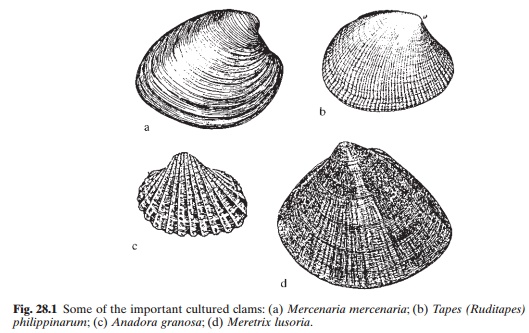Chapter: Aquaculture Principles and Practices: Clams, Scallops and Abalones
Hatchery production of Clams seed
Hatchery production of seed
The technologies of hatchery production are essentially the same as
those employed for oysters. Many commercial hatcheries use salt water from
wells to avoid the need for filtration and sterilization. Such hatcheries are
entirely dependent on cultured algae for larval rearing while others use
cultured algae to rear early larvae and the Wells-Glancy method for growing
spat. As mentioned earlier, mature adults spawn in response to stimulation by
changes of temperature, but if necessary a further stimulation can be provided
by suspensions of sperm or dense phytoplankton infusions. Generally, commercial
hatcheries use fibreglass tanks with conical bottoms and
circular tops, of about 400–1600l capacity. The density of the larvae in
the tanks is about 1–15 per ml and the concentration of algae between 10000 and
100000 cells/ml per day. The hard clam larvae start metamorphosing in six to
eight days at temperatures of about 25°C. The set larvae or spat grow to a size
of 600 mm in two to three weeks, under favourable conditions. Then they are
transferred to nurseries for growing to a size of about 4–6mm.
Nurseries and grow-out facilities employ more or less the same methods,
namely bottom culture, tray or rack culture or suspended culture. Bottom
nurseries in intertidal areas are covered by plastic mesh to protect the seed
from predators. Baffles or similar devices are provided to prevent siltation of
the nurseries. Tray or rack rearing can be carried out in either intertidal or
sub-tidal areas. Trays are placed directly on the bottom or stacked in tiers.
The seed in trays are well protected from predators. For suspended rearing,
rafts, suspended plastic trays and lantern nets or pearl nets are commonly
used. All of them are intended for high-density rearing in the warmer surface
waters, free from benthic predators.
Land-based nurseries often use raceway systems, consisting of shallow
trays or tanks made of fibreglass, cement or wood. Besides the shallow
raceways, where the seed is spread on the bottom and water flows along the
length of the raceway, deeper raceways with tiered racks formed by layers of
mesh sheets are also used. Upflow systems, which cause vertical water flow
through the seed containers, are becoming common in land-based nurseries. The
conditions created by the upflow result in rapid growth.

Related Topics